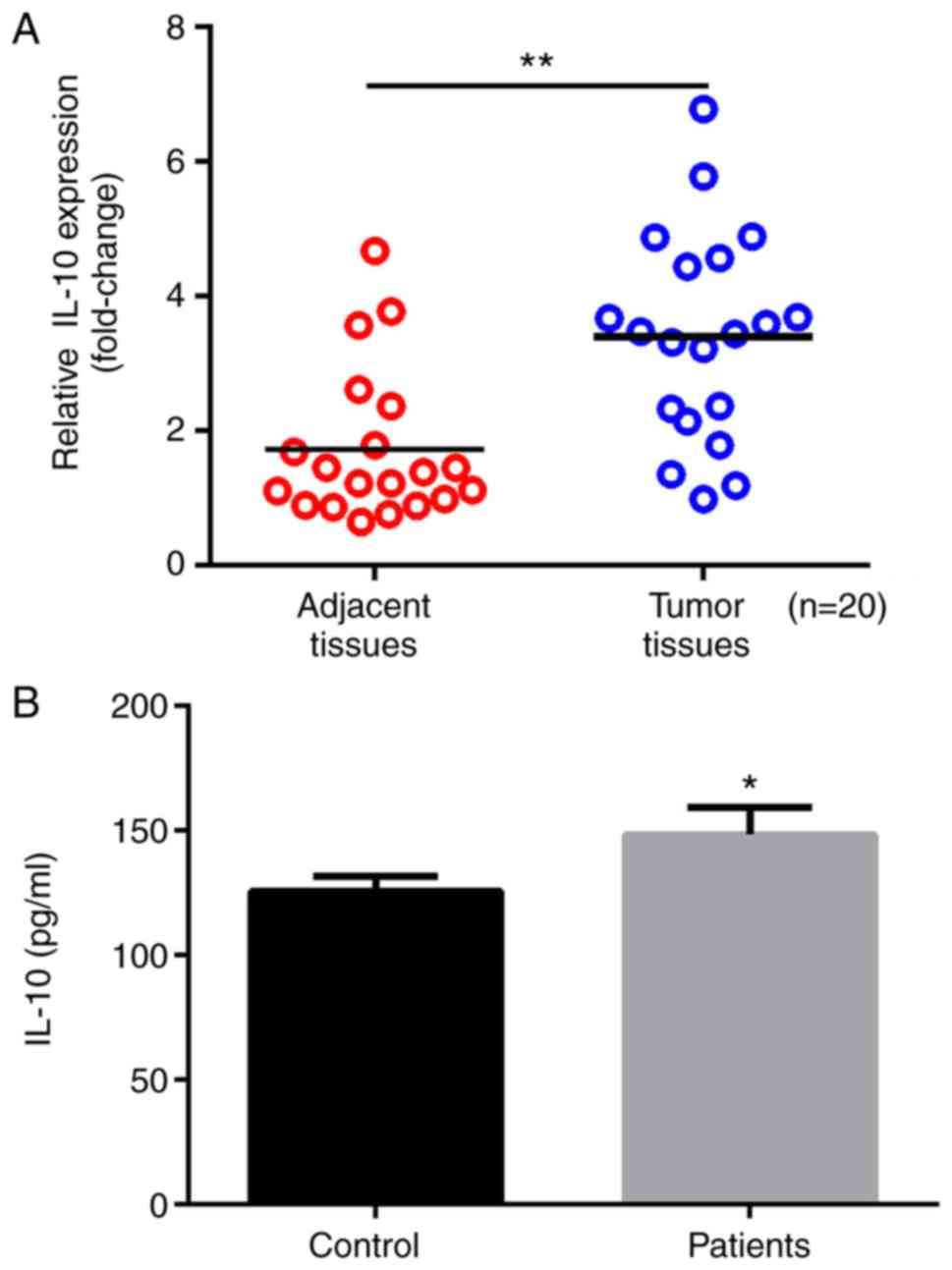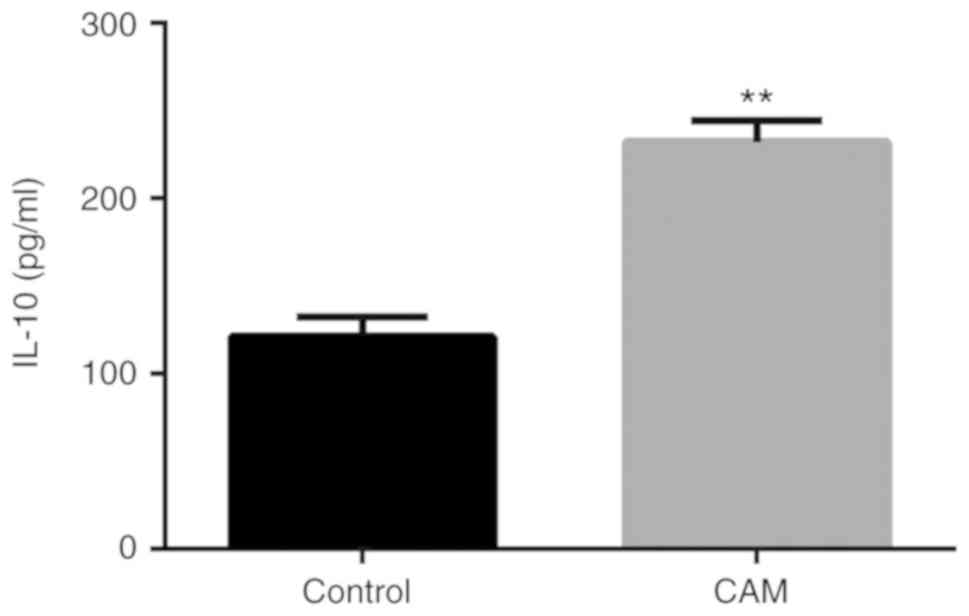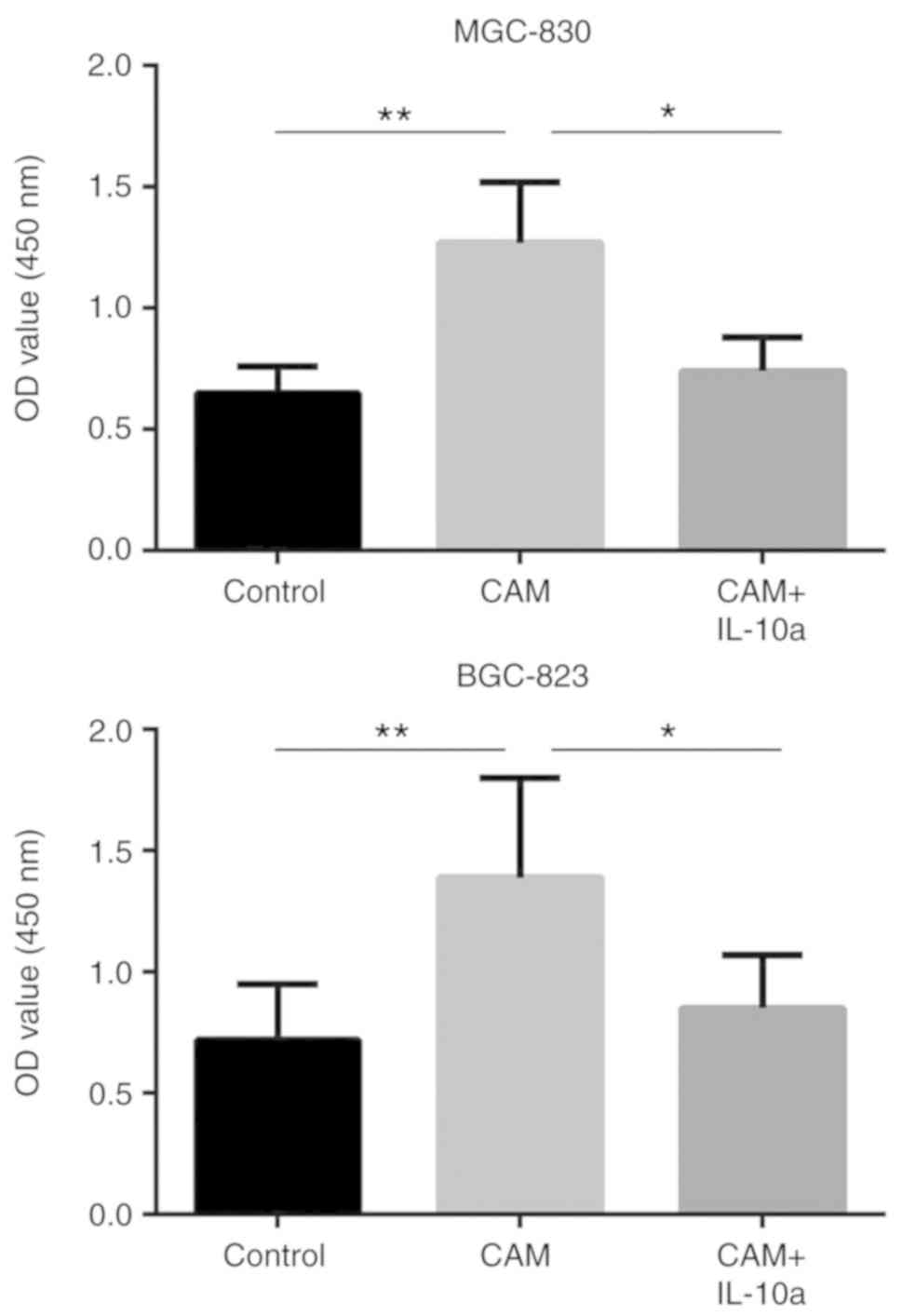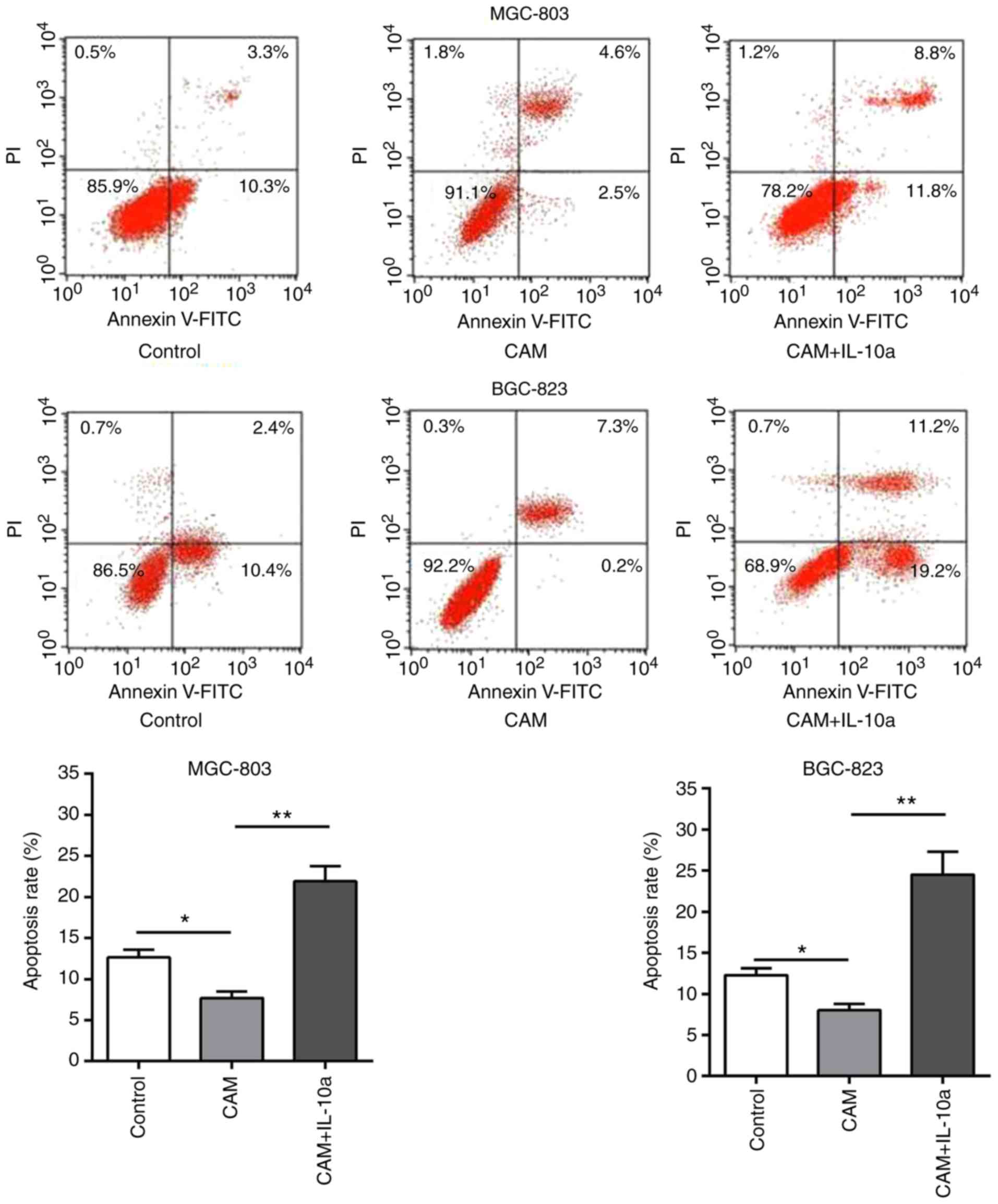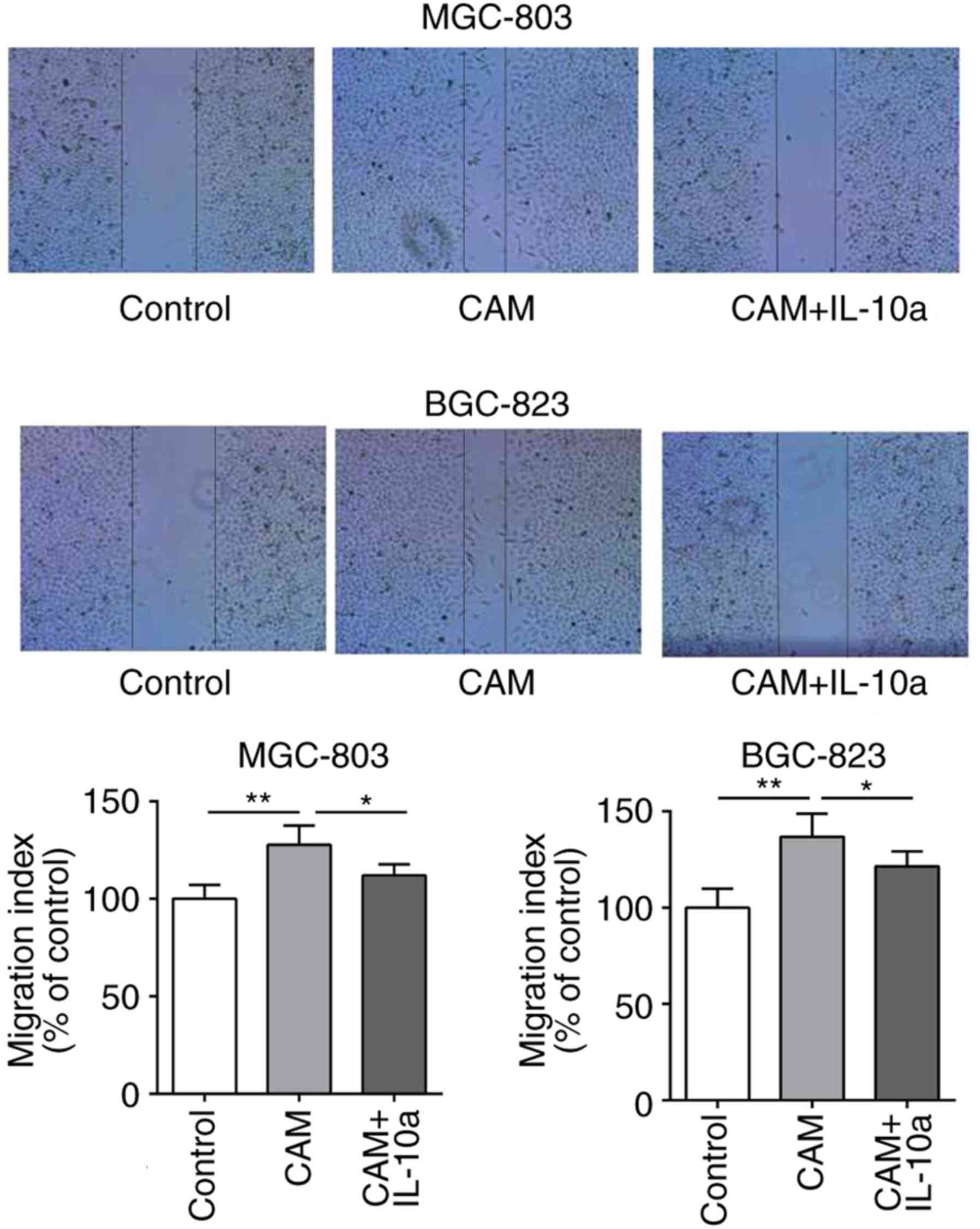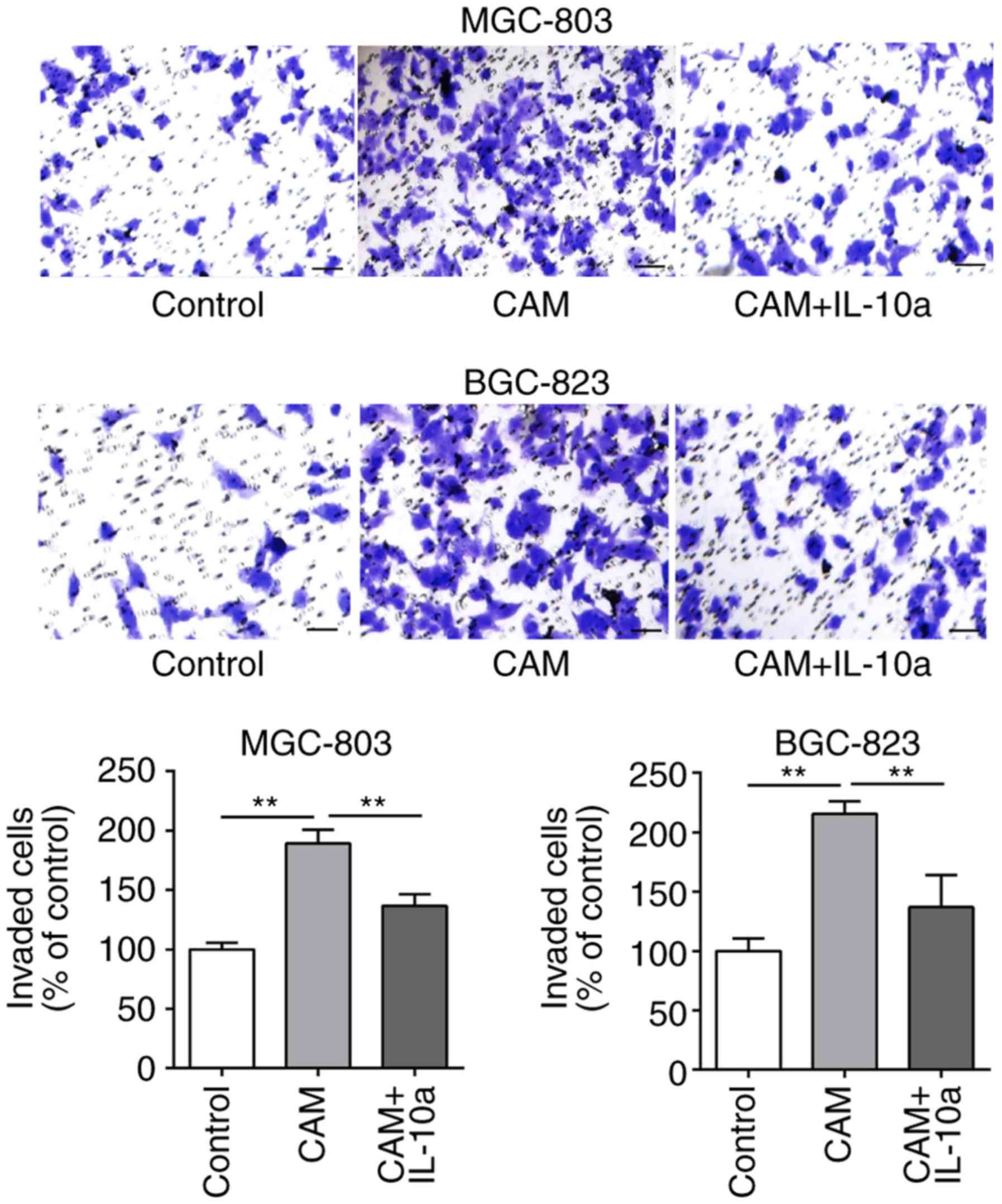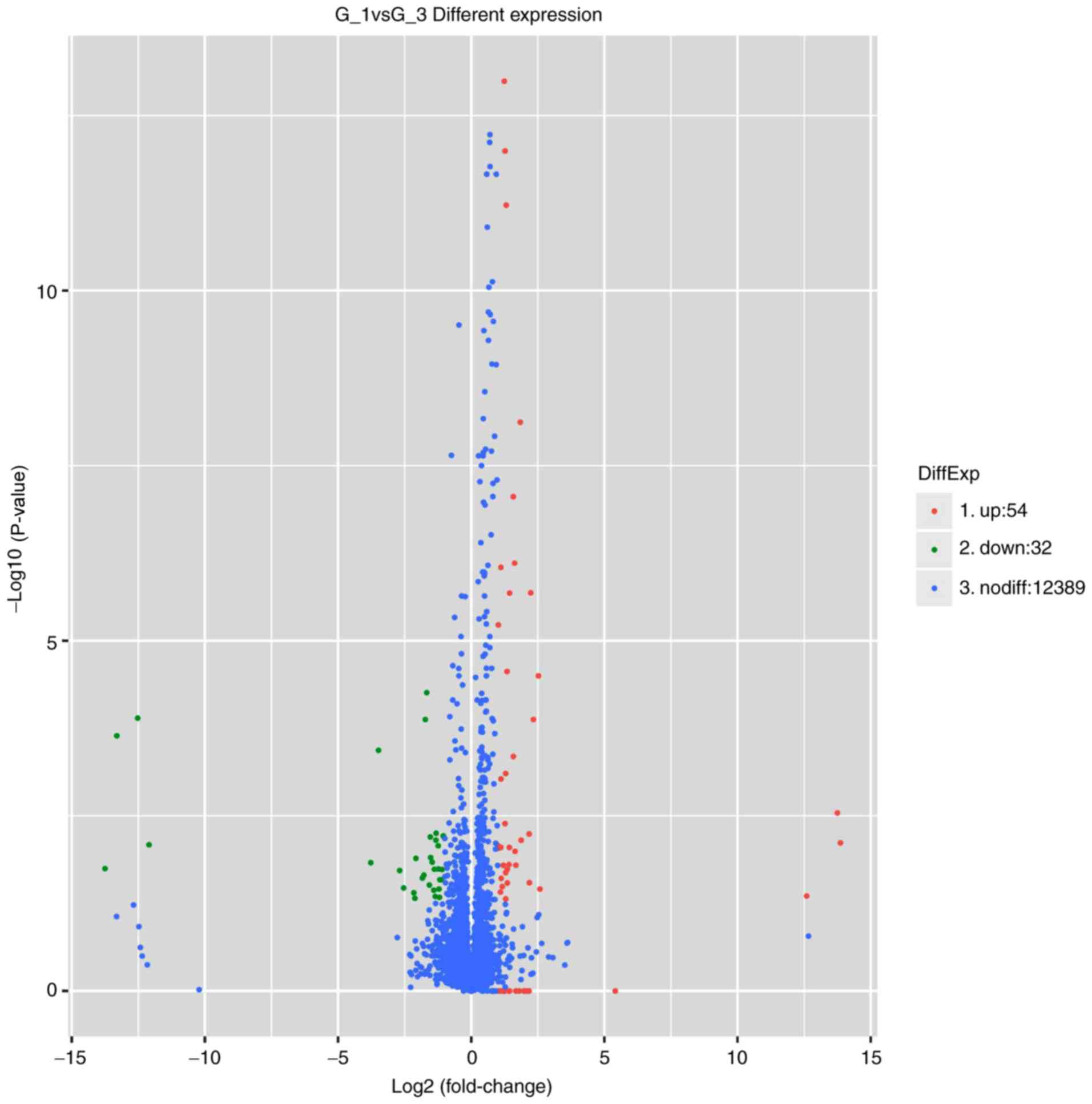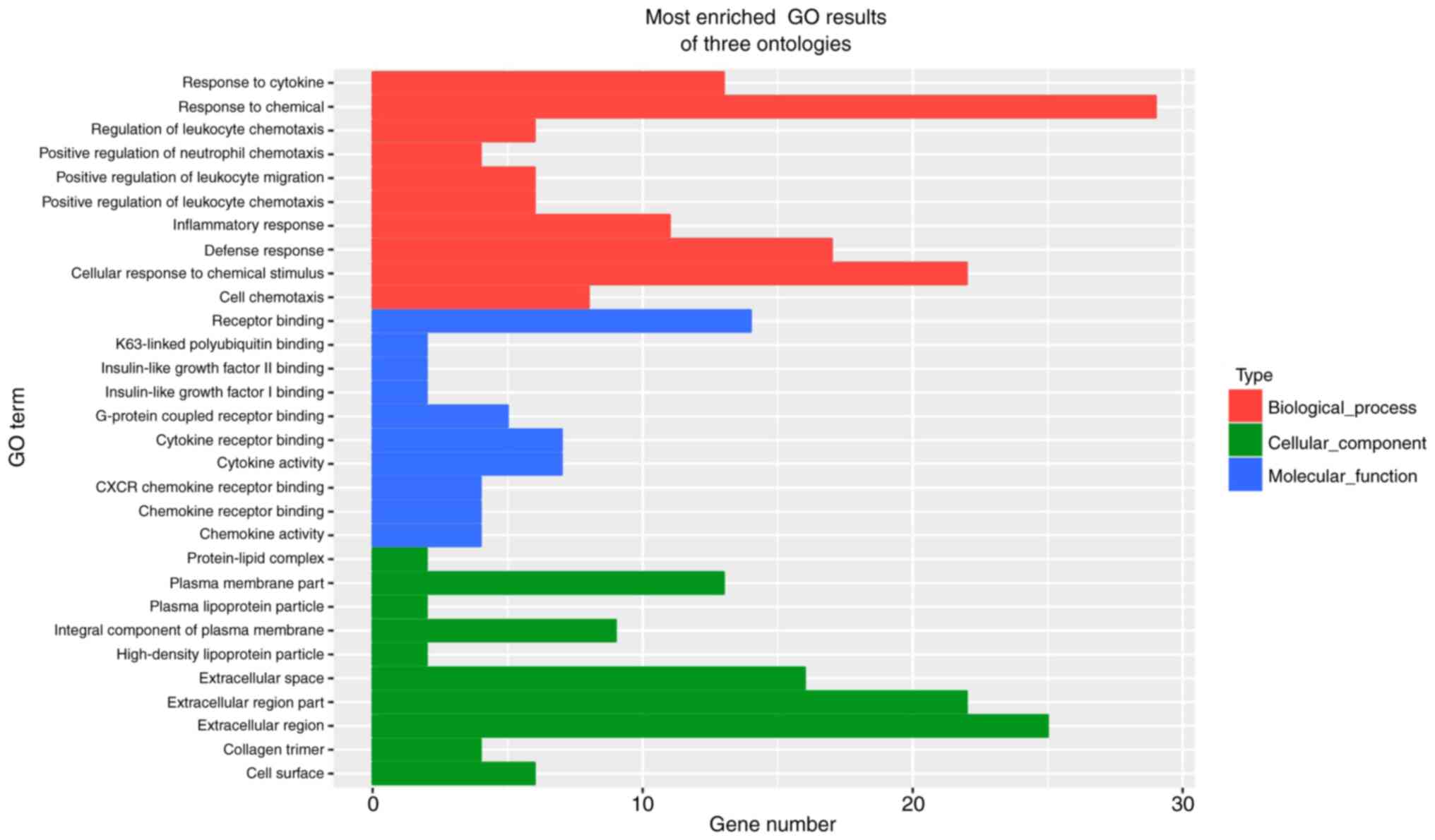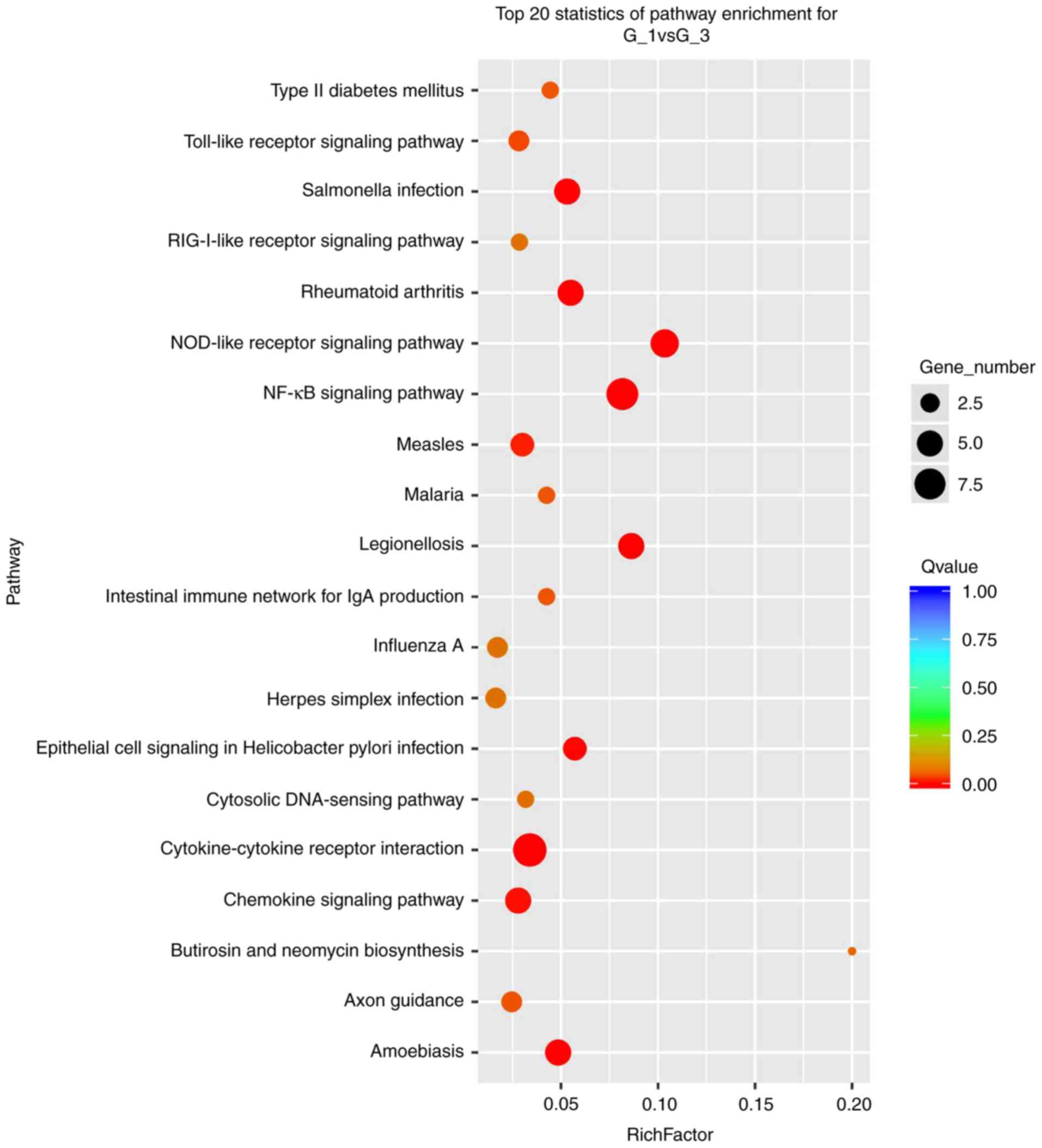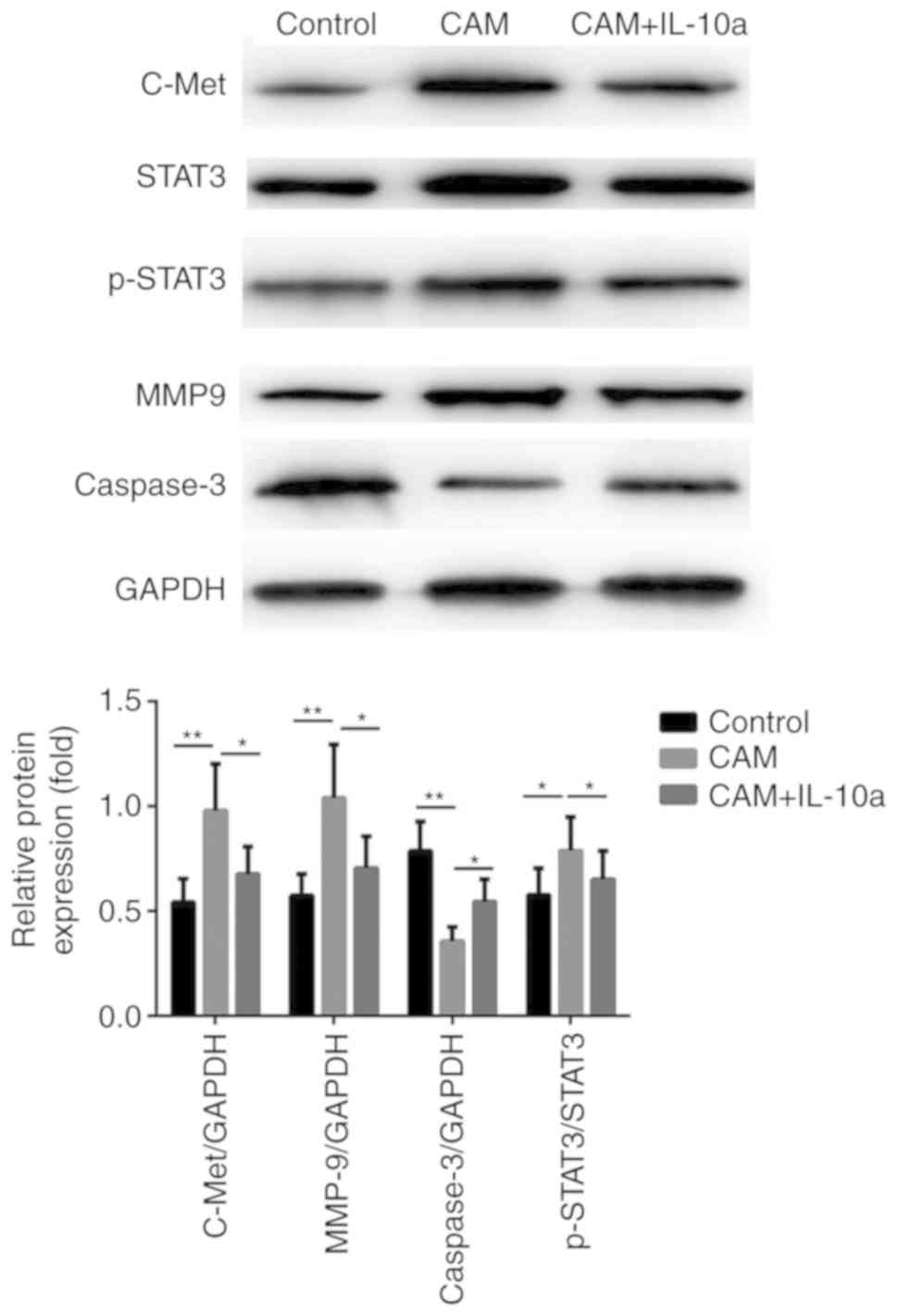Introduction
Gastric cancer is a common human gastrointestinal
cancer, and it is additionally one of the leading causes of
cancer-associated mortality (1).
Similar to numerous other cancer types, the majority of patients
with gastric cancer are diagnosed at an advanced or metastatic
stage when they came to the hospital (2), leading to the poor prognosis of the
disease (3–5). As a result, identifying novel biomarkers
and therapeutic targets for the early diagnosis and prognosis of
gastric cancer is urgently required.
Interleukin (IL)-10 is a cytokine that is encoded by
the IL10 gene. The receptor consists of two different
chains: IL-10 receptor 1 and IL-10 receptor 2 (6). In the human body, IL-10 is primarily
produced by immune cells, including monocytes, type 2 T helper
cells and regulatory T cells. IL-10 may exert its functions by
regulating important signaling pathways, including the
extracellular signal-regulated kinase 1/2, signal transducer and
activator of transcription 3 (STAT3) and nuclear factor-κB
signaling pathways, and affecting the expression of downstream
genes (7,8). The roles of IL-10 in carcinogenesis have
been discussed previously; however, the underlying mechanism
requires further investigation.
In recent years, research on the tumor
microenvironment has attracted increasing attention. Previous
studies have demonstrated that the tumor microenvironment serves a
key role in the progression of cancer (9,10). In the
majority of solid tumors, cancer-associated macrophages (CAMs) are
typically identified as M2 phenotype macrophages and an increased
number of CAMs is correlated with poor prognosis in numerous types
of cancer (11,12), including gastric cancer (13,14). The
results of previous studies have demonstrated that the underlying
interactions among CAMs, cancer cells and cytokines, serve
important roles in the pathogenesis of various types of cancer, and
targeting CAMs has emerged as a novel method for the treatment of
cancer.
The present study aimed to examine the roles and
associated mechanisms of IL-10 secreted by CAMs in the pathogenesis
of gastric cancer. The expression levels of IL-10 were examined in
tumor tissues and serum samples of patients with gastric cancer.
The expression of IL-10 in CAMs and normal macrophages was
compared. Furthermore, the roles of IL-10 in proliferation,
apoptosis and migration of gastric cancer cells were investigated.
RNA-sequencing analysis was performed to identify critical genes
that were differentially expressed in gastric cancer cells with and
without IL-10, and the effect of IL-10 on the activation of the
c-Met/STAT3 signaling pathway was examined. The present results may
provide novel insight for IL-10 as a potential therapeutic target
for gastric cancer.
Materials and methods
Patients and clinical tissue
samples
In total, 20 pairs of gastric tumor tissues and
adjacent normal tissues were collected from patients (11 males and
9 females, 58–72 years old, median age 63) with gastric cancer that
enrolled at the Institute of Digestive Endoscopy and Medical Center
for Digestive Disease between May 2017 to March 2018 at the Second
Affiliated Hospital, Nanjing Medical University (Nanjing, China).
The tissue samples were immediately frozen in liquid nitrogen
following surgery and stored at −80°C until required. The serum of
every patient was additionally collected and stored at −80°C, and
the serum samples of 20 healthy volunteers served as the control
group. All patients were pathologically diagnosed with gastric
cancer, and patients subjected to pre-operative radiotherapy and/or
chemotherapy were excluded from the present study. All patients
signed an informed consent form, and the present study was approved
by the Ethical Committee of Nanjing Medical University.
Cell culture and treatment
For the in vitro differentiation of human
monocytes (THP-1 cells; American Type Culture Collection) into
CAMs, the cells were incubated for 48 h with 20 ng/ml IL-4 and 20
ng/ml IL-13 (PeproTech, Inc.) to obtain M2 polarized macrophages.
Human gastric cell lines MGC-803 and BGC-823 (American Type Culture
Collection) were cultured in RPMI-1640 medium (Invitrogen; Thermo
Fisher Scientific, Inc.) supplemented with 10% fetal bovine serum
(FBS; Invitrogen; Thermo Fisher Scientific, Inc.) at 37°C in a
humidified incubator at 5% CO2. Cells were either
treated with the supernatant from CAMs or the supernatant from
CAMs+IL-10 antibody (cat. no. ab133575; 1:2,000; Abcam) for 72 h
for further analysis. For cell profiling, MGC-803 cells were
treated with IL-10 overexpression vector (Origene) and empty vector
(Origene).
ELISA
The serum expression level of IL-10 in patients and
the expression of IL-10 in the cell culture supernatant of CAMs
were measured using an ELISA kit (cat. no. H009; Nanjing Jiancheng
Bio-Engineering Institute Co., Ltd.) according to the
manufacturer's protocol.
Reverse transcription-quantitative
polymerase chain reaction (RT-qPCR)
Total RNA was extracted from the clinical tissue
samples using TRIzol® reagent (Invitrogen; Thermo Fisher
Scientific, Inc.), according to the manufacturer's protocol. cDNA
was synthesized using the PrimeScript RT Master Mix kit (Takara
Biotechnology Co., Ltd.). Subsequently, qPCR was performed to
examine the expression of IL-10 using SYBR premix Ex Taq (Takara
Biotechnology Co., Ltd.) on an ABI 7500 Real-Time PCR System.
Relative mRNA expression levels were calculated using the
2−∆∆Cq method (15), with
GAPDH as the internal control. The thermocycling conditions were
95°C for 30 sec, followed by 40 cycles of 95°C for 5 sec and 60°C
for 30 sec. The primers were as follows: IL-10,
5′-GCCAGAGCCACATGCTCCTA-3′ (forward) and
5′-GATAAGGCTTGGCAACCCAAGTAA-3′ (reverse); and GAPDH,
5′-AAATGGTGAAGGTCGGTGTGAAC-3′ (forward) and
5′-CAACAATCTCCACTTTGCCACTG-3′ (reverse).
Cell proliferation analysis
Following treatment for 72 h, the proliferation of
MGC-803 and BGC-823 cells was determined by Cell Counting Kit-8
(CCK-8), according to the manufacturer's protocol. Cells were
collected and seeded onto 96-well plates, and 10 µl CCK-8 reagent
was added to each well. Subsequently, the plate was incubated for 4
h. The optical density value was measured at 450 nm with a
microplate reader.
Cell apoptosis analysis
The apoptosis of MGC-803 and BGC-823 cells following
different treatments was analyzed using an Annexin V-fluorescein
isothiocyanate (FITC) apoptosis kit (BD Biosciences) by flow
cytometry. Cells were collected and stained with Annexin V-FITC and
propidium iodide solutions. Subsequently, the apoptosis of the
cells was examined using a FACSCalibur flow cytometer (BD
Biosciences) with CellQuest 6.0 software (BD Biosciences, Franklin
Lakes, NJ, USA).
Scratch wound healing assay
MGC-803 and BGC-823 cells (~2×105) were
cultured until they reached 100% confluence in 6-well plates and
the monolayer was then scratched using a 10 µl pipette tip. The
plate was subsequently incubated at 37°C with 5% CO2 for
24 h. The images of the migration area from five fields of the
control group and treatment group were captured with an inverted
light microscope (magnification, ×200) and analyzed using ImageJ
(National Institutes of Health).
Matrigel invasion assay
A cell invasion assay was conducted using 24-well
plates with Transwell chambers (Corning, Inc.). Cells
(4×104) were seeded onto the upper Matrigel-coated
chambers containing DMEM culture medium (300 µl) without any bovine
serum and the lower chambers were filled with DMEM medium
containing 10% FBS. After incubation for 24 h, cells that had
invaded the membrane were fixed with methanol and stained with
crystal violet. The images of the stained membrane were captured
from five randomly fields using an inverted fluorescence microscope
(magnification, ×200).
Western blot analysis
Total protein was isolated from MGC-803 and BGC-823
cells using a lysis buffer (Beyotime Institute of Biotechnology).
Protein concentrations were determined using a bicinchoninic acid
protein assay kit (Beyotime Institute of Biotechnology). The
proteins were subsequently separated by 10% SDS-PAGE, and
transferred onto a polyvinylidene fluoride membrane, blocked with
5% non-fat milk for 1 h at room temperature and incubated with
primary antibodies against c-Met (cat. no. ab51067; 1:2,000), STAT3
(cat. no. ab76315; 1:5,000), phosphorylated (p)-STAT3 (cat. no.
ab32143; 1:2,000), matrix metalloproteinase (MMP) 9 (cat. no.
ab219372; 1:2,000) and caspase-3 (cat. no. ab13847; 1:500; all
purchased from Abcam) at 4°C overnight. GAPDH was used for
normalization. On day 2, the membranes were incubated with
horseradish peroxidase-conjugated secondary antibodies (cat. no.
ab6721; 1:5,000) and detected using a ChemiDoc™ XRS+
imaging system (Bio-Rad Laboratories, Inc.). Relative protein
expression was quantified by ImageJ software (version 1.47;
National Institutes of Health).
RNA isolation, construction of cDNA
library and RNA-sequencing
TRIzol reagent (Invitrogen; Thermo Fisher
Scientific, Inc.) was used to extract the total RNA from the cell
samples of different treatments, according to the manufacturer's
instructions. The quality of the total RNA was evaluated by
Nanodrop 2000 spectrophotometry (Thermo Fisher Scientific, Inc.).
RNA samples with 260/280 nm optical density ratio 1.8–2.0 were used
for cDNA synthesis using the 1st Strand Enzyme Mix (Vazyme). The
second strand cDNA was synthesized with 2nd Strand Marking Buffer
and 2nd Strand/End Repair Enzyme Mix (Vazyme). Then, the cDNA
library was constructed by PCR as previously published (16), and RNA-sequencing was performed with
Illumina HiSeq XTen (Vazyme).
The quantitative analysis was based on reads per kb
per million reads (RPKM). Differentially expressed genes (DEGs)
were selected by adjusted P<0.05 for multiple tests using the
Benjamini-Hochberg Method (17).
Functional annotation of the genes was performed by Gene Ontology
(GO) analysis (http://geneontology.org). Kyoto Encyclopedia of Genes
and Genomes (KEGG) pathways were annotated using ggplot2 program
(https://ggplot2.tidyverse.org/reference/) and mapped
onto KEGG pathways (18).
Statistical analysis
Data are presented as the mean ± standard deviation.
Comparisons between two groups were analyzed by a t-test, and
comparisons among multiple groups were analyzed by analysis of
variance followed by Turkey's post hoc test. P<0.05 was
considered to indicate a statistically significant difference.
Results
Increased expression of IL-10 in
tissue and serum samples of patients with gastric cancer
The expression levels of IL-10 in tumor tissue sand
adjacent normal tissues from patients with gastric cancer were
detected by RT-qPCR. As presented in Fig.
1A, the expression of IL-10 was significantly increased in
gastric tumor tissues compared with adjacent tissues (P<0.01;
Fig. 1A). Furthermore, IL-10 levels
in serum samples from patients with gastric cancer and healthy
volunteers were compared; the results revealed that the serum
levels of IL-10 were significantly increased in patients with
gastric cancer compared with healthy volunteers (P<0.01;
Fig. 1B).
Increased IL-10 levels in the cell
culture supernatant of CAMs
Subsequently, THP-1 cells were treated with IL-4 and
IL-13 to induce their differentiation to CAMs in vitro,
cultured for 72 h, and the IL-10 levels in the cell culture
supernatant were evaluated by ELISA. It was observed that, compared
with the untreated THP-1 cells, the expression of IL-10 was
significantly upregulated in the cell culture supernatant of CAMs
(P<0.01; Fig. 2).
IL-10 affects proliferation and
apoptosis in gastric cancer cells in vitro
The effects of the cell culture supernatant of CAMs
on the proliferation and apoptosis of MGC-803 and BGC-823 gastric
cancer cells were evaluated by CCK-8 and flow cytometry,
respectively. It was observed that, compared with the untreated
cells, treatment with the cell culture supernatant of CAMs induced
a significant increase in the proliferation (P<0.01; Fig. 3) and a decrease in the apoptosis
(P<0.01; Fig. 4) of MGC-803 and
BGC-823 cells. Notably, addition of an IL-10 inhibitory antibody
blocked these effects (Figs. 3 and
4), suggesting that the
tumor-promoting function of the CAM-conditioned media was mediated
by IL-10.
IL-10 affects migration and invasion
in gastric cancer cells in vitro
The effects of the cell culture supernatant of CAMs
on the migratory and invasive abilities of MGC-803 and BGC-823
cells was examined. As presented in Figs.
5 and 6, treatment with the cell
culture supernatant of CAMs induced a significant increase in the
migratory and invasive abilities of MGC-803 and BGC-823 cells,
whereas the addition of the IL-10 inhibitory antibody partially
blocked the CAM-conditioned media-induced effects.
Differential gene expression profiling
of MGC-803 cells treated with or without IL-10
To profile the differentially expressed genes of
MGC-803 cells treated with IL-10 overexpression vector (Origene)
and empty vector (Origene), genome-wide RNA-sequencing was
performed. As presented in Fig. 7, it
was identified that 86 genes were significantly altered in MGC-803
cells treated with IL-10 compared with untreated MGC-803 cells. Of
those, 54 genes were upregulated and 32 genes were downregulated.
The top upregulated and downregulated genes are listed in Table I. The significantly upregulated genes
included oncogenes IL-6, IL-32, insulin like growth factor binding
protein 3, C-X-C motif chemokine ligand 2, Pim-2 proto-oncogene and
STAT3; the significantly downregulated genes included tumor
suppressors, such as tensin 2 and LIM domain and actin binding 1
(Table I).
 | Table I.Differentially expressed genes by
RNA-sequencing. |
Table I.
Differentially expressed genes by
RNA-sequencing.
| A, Upregulated |
|---|
|
|---|
| Gene name | Log2 fold
change |
|---|
| CXCL2 | 5.4087 |
| CXCL8 | 2.58106 |
| STAT3 | 2.52124 |
| IL-6 | 2.33332 |
| IL-32 | 2.23426 |
| IGFBP3 | 2.184 |
| PIM2 | 2.17285 |
| ANGPTL4 | 2.17171 |
| RND1 | 2.0646 |
| CXCL3 | 1.98878 |
|
| B,
Downregulated |
|
| Gene
name | Log2 fold
change |
|
| SNORD3A | −3.47926 |
| HIST1H2BF | −2.68504 |
| TNS2 | −2.53616 |
| TRIM17 | −2.15445 |
| OGFRP1 | −2.11346 |
| LIMA1 | −2.07622 |
| MARCO | −1.83237 |
| CLYBL | −1.77506 |
| RDH5 | −1.72344 |
| FUT4 | −1.67064 |
To understand the important biological processes
affected by the IL-10 treatment on MGC-803 cells, a GO analysis was
performed. The results revealed that IL-10-affected genes were
enriched in the categories response to chemical, extracellular
region, extracellular region part, cellular response to chemical
stimulus, defense response, extracellular space, receptor binding,
plasma membrane part, response to cytokine, inflammatory response,
integral component of plasma membrane, cell chemotaxis, cytokine
activity, cytokine receptor binding, cell surface, positive
regulation of leukocyte chemotaxis, regulation of leukocyte
chemotaxis, positive regulation of leukocyte migration and
G-protein coupled receptor binding (Fig.
8). Furthermore, in terms of cellular component, it was
identified that the most abundant genes were focused on cytoplasm,
organelle, membrane, membrane-bounded organelle, intracellular
organelle, intracellular membrane-bounded organelle, extracellular
region, cytoplasmic part, extracellular region part, cell periphery
(Fig. 8). In addition, as far as
molecular function is concerned, the most enriched GO terms were
binding, protein binding, ion binding, receptor binding, catalytic
activity, heterocyclic compound binding, organic cyclic compound
binding, metal ion binding and cation binding (Fig. 8). Finally, the results from KEGG
pathway enrichment analysis are presented in Fig. 9. The Nod-like receptor, the NF-kB and
the chemokine signaling pathways were amongst the top 20 most
significantly enriched.
IL-10 regulates the expression of
c-Met/STAT3 in MGC-803 cells in vitro
Based on the sequencing results, the expression of
STAT3 was significantly upregulated in IL-10-treated cells, thus,
RT-qPCR and western blot analysis were performed to verify the
sequencing results and examine the roles of STAT3 in IL-10 induced
tumor-promoting effects. As presented in Fig. 10, treating MGC-803 with the cell
culture supernatant of CAMs induced a significant increase in the
protein expression levels of STAT3, and additionally increased the
phosphorylation of STAT3. c-Met has been confirmed as an upstream
regulator of STAT3 in several previous studies (19,20);
therefore, the effects of IL-10 on the expression of c-Met, as well
as on the downstream effectors of STAT3 caspase-3 and MMP9, were
examined. It was observed that the cell culture supernatant of CAMs
induced a significant increase in the expression of c-Met at the
protein level (Fig. 10).
Furthermore, treatment with the cell culture supernatant of CAMs
resulted in a decreased protein expression of caspase-3 and
increased expression of MMP9 (Fig.
10). Notably, addition of the IL-10 inhibitory antibody
significantly blocked the effects of the CAM-conditioned media on
the c-Met/STAT3 signaling pathway (Fig.
10).
Discussion
IL-10 has been demonstrated to serve regulatory
roles in inflammatory diseases; however, the roles of IL-10 in
carcinogenesis remain unclear. In the present study, the expression
levels of IL-10 in clinical gastric tumor tissues and serum samples
from patients with gastric cancer were examined, and it was
demonstrated that IL-10 was significantly upregulated in gastric
cancer. Furthermore, IL-10 levels were significantly increased in
the cell culture supernatant of CAMs compared with untreated THP-1
cells. In addition, it was identified that IL-10 was able to
regulate the proliferation, apoptosis and migration of gastric
cancer cells in vitro via activation of the c-Met/STAT3
signaling pathway.
Accumulating evidence has revealed that the tumor
microenvironment serves important roles in the pathogenesis of
gastric cancer. Numerous studies have demonstrated that M2
macrophages contribute to cancer progression, including tumor
growth, invasion and metastasis directly or indirectly, through
paracrine activation by various growth factors and cytokines
(21,22). Notably, the activation of these
procarcinogenic macrophages, termed CAMs, is not reversible. In the
present study, it was demonstrated for the first time, to the best
of our knowledge, that IL-10 secreted by CAMs enhanced cell
proliferation, migration and invasion in gastric cancer cells.
In the present study, genome-wide RNA-sequencing was
performed to further elucidate the global genetic alterations
resulting by IL-10 stimulation in gastric cancer cells. Notably, 86
genes were identified to be significantly altered between untreated
cells and cells treated with IL-10. GO analysis demonstrated that
IL-10 treatment regulated genes involved in a number of principal
biological events, including in response to chemical, response to
cytokine, inflammatory response, cell chemotaxis, cytokine
activity, positive regulation of leukocyte chemotaxis, regulation
of leukocyte chemotaxis, positive regulation of leukocyte migration
and G-protein coupled receptor binding. Therefore, CAMs may
contribute to the reprogramming of the cancer cells via cytokine
secretion, such as IL-10.
STAT3 was identified as one of the significantly
upregulated genes upon IL-10 stimulation, and the present results
confirmed that treatment of gastric cancer cells with the cell
culture supernatant of CAMs induced a significant increase in the
protein expression levels and the phosphorylation of STAT3. c-Met,
also termed hepatocyte growth factor receptor, is an upstream
regulator of STAT3, which has been identified as an oncogene and
potential therapeutic target (23,24).
Upregulation of c-MET may increase the expression and
phosphorylation of STAT3, wherein the activated STAT3 directly
regulates genes involved in proliferation (including cyclin D1,
c-Myc, p53 and p21), survival (including Bcl-2, Bcl-xL, MCL1
apoptosis regulator and survivin), metastasis (including MMP2 and
MMP9) and angiogenesis (including vascular endothelial growth
factor) in numerous types of cancer. The role of c-MET/STAT3
signaling in gastric cancer has been previously discussed in
multiple studies (25,26), including a previous study from our
group (27). To further examine
whether c-Met/STAT3 signaling may serve a key role in IL-10-induced
tumor-promoting behaviors of gastric cancer cells, the expression
levels of c-Met, and of downstream effectors STAT3, MMP9 and
caspase-3, were examined following treatment with CAM-conditioned
media. It was observed that treatment with the cell culture
supernatant of CAMs induced a significant increase in the
expression of c-Met, a decrease in the expression of caspase-3, and
an increase in the expression of MMP9; however, addition of an
inhibitory IL-10 antibody significantly blocked these effects,
suggesting that IL-10 secreted by CAMs may regulate the
proliferation, apoptosis and migration of the gastric cancer cells
by activating the c-Met/STAT3 signaling pathway. Notably, it was
observed that the cell culture supernatant of CAMs had no effect on
the expression of c-Met at the mRNA level (data not shown),
suggesting that the effect of IL-10 on the expression of c-Met may
be post-transcriptional.
Consistent with the present results, previous
studies have suggested that CAMs may be novel prospective
therapeutic targets in cancer immunotherapy. As a crucial component
within the cancer microenvironment, CAMs are activated at the early
stages and widely contribute to tumor initiation, growth, invasion,
metastasis and therapy resistance, via growth factors, cytokines
and other biological molecules. Current CAM-targeted cellular
therapies have undergone preclinical evaluation and clinical trials
(28), including inhibition of CAM
activation, blockage of CAM-cancer cell interaction, and
destruction of metabolism uncoupling between CAMs and cancer cells.
For example, inhibition of IL-10 secretion from CAMs in gastric
cancer may be a promising therapeutic strategy.
In summary, it was demonstrated that there was an
increased expression of IL-10 in gastric cancer tumor specimens,
which was correlated with the advanced clinicopathological stages
of patients. Additionally, IL-10 was markedly increased in the
CAMs. Furthermore, treatment with IL-10 induced an increase in the
proliferation and migration of MGC-803 and BGC-823 cells; however,
it decreased apoptosis via activation of the c-Met/STAT3 signaling
pathway. IL-10 regulates a global altered gene expression profile
in gastric cancer cells, including metabolic signaling pathways,
cell proliferation and migration. Together, these results suggested
that IL-10 produced by CAMs promoted the proliferation and invasion
of gastric cancer.
Acknowledgements
Not applicable.
Funding
No funding was received.
Availability of data and materials
The datasets used and/or analyzed during the current
study are available from the corresponding author on reasonable
request.
Authors' contributions
LC, XZ, WG, MZ and YC conducted the experiments. XZ,
WG, MZ and YC analyzed the data. LT, XY, QY and ZL interpreted the
data. LC drafted the manuscript. YS was involved in the conception
and design of the manuscript. All authors read and approved the
final manuscript.
Ethics approval and consent to
participate
All patients signed an informed consent form, and
the study was approved by the Ethical Committee of Nanjing Medical
University.
Patient consent for publication
Not applicable.
Competing interests
The authors declare that they have no competing
interests.
References
|
1
|
Yao Q, Tu C, Lu D, Zou Y, Liu H and Zhang
S: Clinicopathological significance of the
microRNA-146a/WASP-family verprolin-homologous protein-2 axis in
gastric cancer. Cancer Sci. 108:1285–1292. 2017. View Article : Google Scholar : PubMed/NCBI
|
|
2
|
Zhang DY, Wang J, Zhang GQ, Chu XQ, Zhang
JL and Zhou Y: Correlations of MMP-2 and TIMP-2 gene polymorphisms
with the risk and prognosis of gastric cancer. Int J Exp Med.
8:20391–20401. 2015.
|
|
3
|
Zhu X, Tian X, Yu C, Shen C, Yan T, Hong
J, Wang Z, Fang JY and Chen H: A long non-coding RNA signature to
improve prognosis prediction of gastric cancer. Mol Cancer.
15:602016. View Article : Google Scholar : PubMed/NCBI
|
|
4
|
Sakamoto N, Tsujimoto H, Takahata R, Cao
B, Zhao P, Ito N, Shimazaki H, Ichikura T, Hase K, Vande Woude GF
and Shinomiya N: MET4 expression predicts poor prognosis of gastric
cancers with Helicobacter pylori infection. Cancer Sci.
108:322–330. 2017. View Article : Google Scholar : PubMed/NCBI
|
|
5
|
Higuchi K, Inokuchi M, Takagi Y, Ishikawa
T, Otsuki S, Uetake H, Kojima K and Kawano T: Cadherin 5 expression
correlates with poor survival in human gastric cancer. J Clin
Pathol. 70:217–221. 2017. View Article : Google Scholar : PubMed/NCBI
|
|
6
|
Mosser DM and Zhang X: Interleukin-10: New
perspectives on an old cytokine. Immunol Rev. 226:205–218. 2008.
View Article : Google Scholar : PubMed/NCBI
|
|
7
|
Pereira L, Font-Nieves M, Van den Haute C,
Baekelandt V, Planas AM and Pozas E: IL-10 regulates adult
neurogenesis by modulating ERK and STAT3 activity. Front Cell
Neurosci. 9:572015. View Article : Google Scholar : PubMed/NCBI
|
|
8
|
Liu BS, Cao Y, Huizinga TW, Hafler DA and
Toes RE: TLR-mediated STAT3 and ERK activation controls IL-10
secretion by human B cells. Eur J Immunol. 44:2121–2129. 2014.
View Article : Google Scholar : PubMed/NCBI
|
|
9
|
Chen D, Xie J, Fiskesund R, Dong W, Liang
X, Lv J, Jin X, Liu J, Mo S, Zhang T, et al: Chloroquine modulates
antitumor immune response by resetting tumor-associated macrophages
toward M1 phenotype. Nat Commun. 9:8732018. View Article : Google Scholar : PubMed/NCBI
|
|
10
|
Ohno Y, Toyoshima Y, Yurino H, Monma N,
Xiang H, Sumida K, Kaneumi S, Terada S, Hashimoto S, Ikeo K, et al:
Lack of interleukin-6 in the tumor microenvironment augments type-1
immunity and increases the efficacy of cancer immunotherapy. Cancer
Sci. 108:1959–1966. 2017. View Article : Google Scholar : PubMed/NCBI
|
|
11
|
Lan C, Huang X, Lin S, Huang H, Cai Q, Wan
T, Lu J and Liu J: Expression of M2-polarized macrophages is
associated with poor prognosis for advanced epithelial ovarian
cancer. Technol Cancer Res Treat. 12:259–267. 2013. View Article : Google Scholar : PubMed/NCBI
|
|
12
|
Herrera M, Herrera A, Domínguez G, Silva
J, García V, García JM, Gómez I, Soldevilla B, Muñoz C, Provencio
M, et al: Cancer-associated fibroblast and M2 macrophage markers
together predict outcome in colorectal cancer patients. Cancer Sci.
104:437–444. 2013. View Article : Google Scholar : PubMed/NCBI
|
|
13
|
Liu JY, Peng CW, Yang GF, Hu WQ, Yang XJ,
Huang CQ, Xiong B and Li Y: Distribution pattern of tumor
associated macrophages predicts the prognosis of gastric cancer.
Oncotarget. 8:92757–92769. 2017.PubMed/NCBI
|
|
14
|
Yin S, Huang J, Li Z, Zhang J, Luo J, Lu C
and Xu H and Xu H: The prognostic and clinicopathological
significance of tumor-associated macrophages in patients with
gastric cancer: A meta-analysis. PLoS One. 12:e01700422017.
View Article : Google Scholar : PubMed/NCBI
|
|
15
|
Livak KJ and Schmittgen TD: Analysis of
relative gene expression data using real-time quantitative PCR and
the 2(-Delta Delta C(T)) method. Methods. 25:402–408. 2001.
View Article : Google Scholar : PubMed/NCBI
|
|
16
|
Salvi A, Abeni E, Portolani N, Barlati S
and De Petro G: Human hepatocellular carcinoma cell-specific miRNAs
reveal the differential expression of miR-24 and miR-27a in
cirrhotic/non-cirrhotic HCC. Int J Oncol. 42:391–402. 2013.
View Article : Google Scholar : PubMed/NCBI
|
|
17
|
Benjamini Y and Hochberg Y: Controlling
the false discovery rate: A practical and powerful approach to
multiple testing. J R Statist Soc Ser B. 57:289–300. 1995.
|
|
18
|
He F, Ai B and Tian L: Identification of
genes and pathways in esophageal adenocarcinoma using
bioinformatics analysis. Biomed Rep. 9:305–312. 2018.PubMed/NCBI
|
|
19
|
Wu JC, Wang CT, Hung HC, Wu WJ, Wu DC,
Chang MC, Sung PJ, Chou YW, Wen ZH and Tai MH: Heteronemin is a
novel c-Met/STAT3 inhibitor against advanced prostate cancer cells.
Prostate. 76:1469–1483. 2016. View Article : Google Scholar : PubMed/NCBI
|
|
20
|
Syed ZA, Yin W, Hughes K, Gill JN, Shi R
and Clifford JL: HGF/c-met/Stat3 signaling during skin tumor cell
invasion: Indications for a positive feedback loop. BMC Cancer.
11:1802011. View Article : Google Scholar : PubMed/NCBI
|
|
21
|
Ding H, Zhao L, Dai S, Li L, Wang F and
Shan B: CCL5 secreted by tumor associated macrophages may be a new
target in treatment of gastric cancer. Biomed Pharmacother.
77:142–149. 2016. View Article : Google Scholar : PubMed/NCBI
|
|
22
|
Yamaguchi T, Fushida S, Yamamoto Y,
Tsukada T, Kinoshita J, Oyama K, Miyashita T, Tajima H, Ninomiya I,
Munesue S, et al: Tumor-associated macrophages of the M2 phenotype
contribute to progression in gastric cancer with peritoneal
dissemination. Gastric Cancer. 19:1052–1065. 2016. View Article : Google Scholar : PubMed/NCBI
|
|
23
|
Gholamin S, Fiuji H, Maftouh M, Mirhafez
R, Shandiz FH and Avan A: Targeting c-MET/HGF signaling pathway in
upper gastrointestinal cancers: Rationale and progress. Curr Drug
Targets. 15:1302–1311. 2014. View Article : Google Scholar : PubMed/NCBI
|
|
24
|
Marano L, Chiari R, Fabozzi A, De Vita F,
Boccardi V, Roviello G, Petrioli R, Marrelli D, Roviello F and
Patriti A: C-Met targeting in advanced gastric cancer: An open
challenge. Cancer Lett. 365:30–36. 2015. View Article : Google Scholar : PubMed/NCBI
|
|
25
|
Ding X, Ji J, Jiang J, Cai Q, Wang C, Shi
M, Yu Y, Zhu Z and Zhang J: HGF-mediated crosstalk between
cancer-associated fibroblasts and MET-unamplified gastric cancer
cells activates coordinated tumorigenesis and metastasis. Cell
Death Dis. 9:8672018. View Article : Google Scholar : PubMed/NCBI
|
|
26
|
Okamoto W, Okamoto I, Arao T, Yanagihara
K, Nishio K and Nakagawa K: Differential roles of STAT3 depending
on the mechanism of STAT3 activation in gastric cancer cells. Br J
Cancer. 105:407–412. 2011. View Article : Google Scholar : PubMed/NCBI
|
|
27
|
Wei X, Juan ZX, Min FX, Nan C, Hua ZX,
Qing FZ and Zheng L: Recombinant immunotoxin anti-c-Met/PE38KDEL
inhibits proliferation and promotes apoptosis of gastric cancer
cells. J Exp Clin Cancer Res. 30:672011. View Article : Google Scholar : PubMed/NCBI
|
|
28
|
Ries CH, Cannarile MA, Hoves S, Benz J,
Wartha K, Runza V, Rey-Giraud F, Pradel LP, Feuerhake F, Klaman I,
et al: Targeting tumor-associated macrophages with anti-CSF-1R
antibody reveals a strategy for cancer therapy. Cancer Cell.
25:846–859. 2014. View Article : Google Scholar : PubMed/NCBI
|















